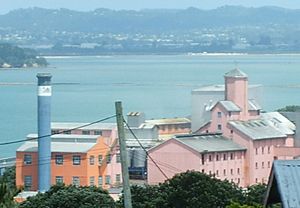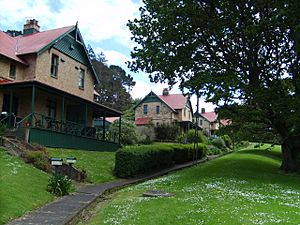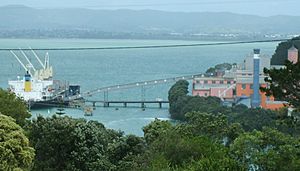Chelsea Sugar Refinery facts for kids
Quick facts for kids Chelsea Sugar |
|
|---|---|
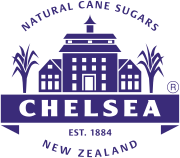 |
|
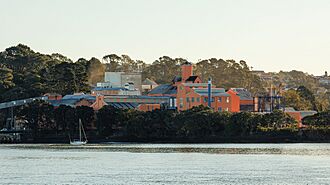
Chelsea Sugar, as seen from Birkenhead Wharf
|
|
| General information | |
| Coordinates | 36°49′16″S 174°43′26″E / 36.821°S 174.724°E |
| Completed | 1884 |
| Designated: | 26 June 2009 |
| Reference #: | 7792 |
The New Zealand Sugar Company Limited is a famous business in Birkenhead, New Zealand. It sits on the northern side of Auckland's Waitematā Harbour. People often call it "Chelsea Sugar" because of its popular sugar brand. The place itself is known as the "Chelsea Sugar Refinery".
This refinery started way back in 1884. It's still New Zealand's main supplier of sugar for homes and food companies. Even when other sugar products could be imported in the 1980s, Chelsea Sugar stayed strong. They also send their sugar to other countries. The refinery has its own deepwater port. Large ships bring raw sugar from all over the world about every six weeks.
Contents
The Story of Chelsea Sugar
For most of the 1800s, New Zealand had to import all its sugar. The government wanted New Zealand to make its own sugar. In 1882, they offered a reward to the first company that could produce sugar locally.
An Australian company, the Colonial Sugar Refining Company, was interested. They looked for good places in New Zealand. They bought 160 acres of farmland in Birkenhead. This land later grew to 450 acres.
The location was perfect for a refinery. The Waitemata Harbour had deep water close to shore for a port. Fresh water came from Duck Creek, which ran through the land. There was also plenty of land and timber for building. The refinery's first customs officer named the site "Chelsea". He named it after his hometown, Chelsea in England.
How the New Zealand Sugar Company Began
The "New Zealand Sugar Company" was officially formed in June 1883. It was created by the Colonial Sugar Refining Company and the Victorian Sugar Company. Some important Auckland businessmen also joined. These included Sir Frederick Whitaker and Allan Kerr Taylor.
However, the price of sugar around the world dropped in the 1880s. Because of this, the New Zealand Sugar Company rejoined its parent company, Colonial Sugar, in 1888. In 1959, the current New Zealand Sugar Company was formed. This allowed it to make its own decisions. Today, Wilmar International owns 75% of the company. Mackay Sugar owns the other 25%.
Building the Refinery
Work on the new refinery began in 1883. About 150 workers prepared the land. They leveled the ground and filled in a natural lagoon. They also built wharves by blasting rock. Dams were created using bricks made right there on the site.
By 1884, the refinery was ready and started working. It has been running 24 hours a day ever since. Out of the 150 workers who built the refinery, 100 stayed to work there. Most of them moved from Auckland and settled nearby. Some of the first machines came from Greenock in Scotland. Many of these old machines are still at the site. They show the rich history of industry there.
Chelsea Village: A Company Town
When the refinery was being built, managers used existing farm cottages. But most workers lived in tents and temporary homes. This temporary settlement was replaced by Chelsea Village. The company built 35 cottages within the refinery grounds. It was planned to be a "model town." It had gardens, a church, a reading room, a school, and a shop.
However, the village did not last long. The houses in lower areas were damp. By the early 1890s, some were empty. By 1900, it was called the "barracks" and mostly housed single men. In 1905, health officials said the village was not good enough. The worst houses were torn down. The rest were sold and moved away. Some of these moved cottages can still be seen in older streets around Birkenhead. The church, now called St Peters, was moved to Verrans Corner.
The company wanted its skilled workers to stay close by. So, in 1909, they built four brick houses. These houses are still owned by Chelsea Sugar. They are rented to private people today. For other workers, the company offered cheap housing loans. These loans helped build over a third of Birkenhead's new houses between 1910 and 1926. Many were on streets near the refinery, like Colonial Road and Huka Road.
Life as a Sugar Worker
The famous poet James K Baxter worked at Chelsea as a cleaner in 1969. He was there for three weeks. He later wrote a poem about his unhappy experience. But not all workers felt the same way. It was known as a place of hard work. However, there was a strong community spirit. The company also offered many benefits. The housing loans and steady jobs meant many workers stayed for a long time. Often, whole families worked at the refinery for generations. In the 2000s, about 240 people worked at the refinery.
Chelsea Sugar's Impact on the Area
How Chelsea Sugar Shaped Birkenhead
Before the Auckland Harbour Bridge opened in 1959, getting to the North Shore from Auckland city was mostly by ferry. Most people in the area worked locally. Chelsea Sugar was a major reason for Birkenhead's growth. It was a central part of the community. Many people thought Birkenhead was a "company town" because Chelsea was the main employer.
In 1900, Birkenhead had 1000 people. One-third of the men worked at the refinery. Local farmers often worked at Chelsea during their off-season. When the Harbour Bridge opened, the North Shore became a good place to live. Chelsea Sugar then sold over 100 hectares of land for new homes. This area is now the suburb of Chatswood.
Before the sugar works, the area had farms and orchards. There was a small village by Birkenhead Wharf. Within four years of the refinery opening, Birkenhead became a borough. The town grew up the hill towards Chelsea Village. Shops were set up at Highbury, between the two original villages. Most local shops relied on business from Chelsea and its workers. Workers also got involved in local government. The refinery's shift sirens could be heard everywhere in Birkenhead. They acted like a clock for everyone.
A Second Port for Auckland
The site was chosen because of its deep water access. This allowed a port to be built in 1884. Raw sugar came from places like Fiji, Cuba, and Australia. Before the Auckland Harbour Bridge was built, finished sugar products were shipped out from this wharf. Other goods like coal and mail also came through Chelsea Wharf.
This port still receives ships today. These are usually large bulk carriers. They deliver up to 30,000 tons of raw sugar. It is a private port. However, ship arrivals are recorded by the Ports of Auckland. They also follow Customs and MAF rules. Because the ships are large, they need a special pilot to guide them. The Ports of Auckland's Harbour Control manages this.
Some of the land was owned by the Ports of Auckland. Chelsea Sugar leased it. In 1997, Chelsea was allowed to buy this land, which was nine hectares in total. The port is located further into the harbour than the Harbour Bridge. This is why the bridge has a very tall and wide central section.
Buildings and Culture
Chelsea Sugar is more than just a landmark. It has been very important to the local community. It helps to keep local history alive and supports local events. They sponsor things like school trips and books about local history.
The company wants to save its early history for future generations. It has given its old records to the Birkenhead Public Library. These "Chelsea Archives" include company records, wage books, and legal files.
Heritage New Zealand recognizes the importance of the site's buildings and history. The old factory buildings, the manager's house, and the brick houses are listed as important. The whole site is valued for its industrial heritage. It is one of the largest industrial sites in New Zealand. It is also one of the few sugar refineries in the South Pacific. It helped New Zealand become an important economic country.
Throughout its history, Chelsea has allowed people to visit its large grounds. These grounds include wetlands, lakes, open spaces, and bush. The company has made sure this parkland and its access are kept for everyone.
Chelsea Sugar also played a part in starting a local football team. The club, now called Glenfield Rovers, began as Chelsea F.C. in 1960. It was first a social club for refinery staff. It grew into one of the strongest teams in the Auckland area.
Chelsea Sugar Today
Chelsea Sugar operates 24 hours a day, five days a week. It is still New Zealand's top sugar brand. Chelsea buys large amounts of raw sugar from around the world. This sugar arrives by ship and is processed and packaged at the refinery. Sales offices and warehouses across the country help distribute 200,000 tonnes of sugar each year. They supply both homes and food manufacturers.
About 20% of Chelsea's sugar is exported. Most of it goes to Australia and the Pacific. New Zealand has a free market economy. This means there are no special taxes or rules for sugar imports. So, Chelsea operates completely in a competitive market.
Chelsea also provides money and support for many local groups and projects. They also fund the Sugar Research Advisory Service. This is an independent group that studies sugar.


